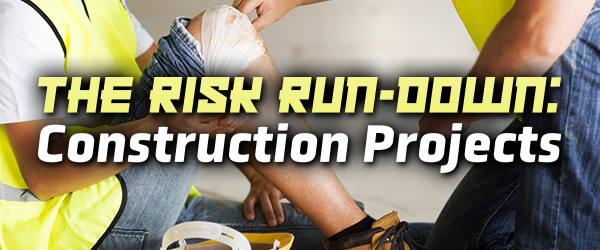There are many things in a construction project that can cost you money. Going over-budget, having equipment breakdowns, and battling the weather can all result in lost time and revenue. While you can’t always plan for these things, you can create a risk management strategy that will help prepare you and your team for these scenarios. Risk management also helps reduce the potential injuries that could occur, protecting your employees and anyone who happens to be visiting the job site.
But risk management does require investing some time and resources into analyzing potential risks and determining the appropriate response to each. You may find yourself facing a wide range of risks—which do you prioritize? How do you appropriately manage many different risks that may be spread over a number of different types of issues?
Classify the Risk
The first thing you need to do when you identify a risk is to classify it. In the construction industry, risks can be classified into one of three categories: financial risks, schedule risks, and design risks. If you don’t classify your risks, it can be quite difficult to determine how to deal with that risk or what the risk could affect.
The financial risks are anything that could cost you to go over budget or lose a significant amount of money. For example, if necessary equipment were to break down in the middle of a job, paying to have that equipment repaired quickly or replaced could cost you a significant amount of money. Failing to secure the correct permits could also be a financial risk if you were to be subjected to a large fine due to the lack of correct paperwork.
Schedule risks are those risks that would primarily affect your timetable. Unexpected weather that prevents your team from doing any work on a project for over a week would be a risk that falls under this category.
Design risks are any type of risk that pertains to the overall design of a project. One example of this type of risk would be disagreements with clients that prevent you from finalizing the overall design before construction is due to begin. You can risk starting on some parts of the project before the final design is done.
The Top 5 Construction Risks
In the construction industry, there are a number of different risks that can impact your company financially, put you behind schedule, or cause issues with your project’s design. Some of these risks, however, are much more prevalent than others. Here are the top five risks you’re likely to run into:
Safety Risks
You’re always going to face safety risks and hazards in the construction industry. The best way to reduce these risks is to make certain that your crew is aware of all the required safety regulations and always follows them. This includes being aware of any of their fellow employees who may not speak English as their first language. While these employees may be very good at their jobs, they may not always understand the risks or dangers due to a language barrier. By providing dual language signage and other support, you can help reduce these risks.
Worker Issues
Another risk you may face is a lack of qualified workers. While this is almost always a challenge for construction companies, it’s not always easy to find the skilled workers you need to meet those demands. More than half of the construction contractors have said that they’ve had trouble finding skilled employees. That leaves you the choice of hiring those who may not do the job as well as you would like or turning down work because you don’t have the crew.
Poor Work Conditions and Related Issues
Another risk you’re likely to face is poor work conditions. These issues could be related to the weather or to seasonal difficulties. For example, your risk of dealing with harsh weather increases in the winter, especially if you’re in the northern part of the country. Always factor in the risks of weather when you’re preparing a budget and a timetable.
Lack of Documentation
When you don’t have the proper documents needed for constructing a building or any other project, it’s going to cause issues. Many people might assume the days of using paper blueprints and other documents are over, but as many as 40 percent of modern construction crews still make use of paper documents. If one of those documents gets lost, work could grind to a halt while you wait for another copy. Make certain you have all the documents on hand that you need and consider switching to a digital format if that’s an option for you.
Inconsistent Reports
Is there room for errors in your reporting? If you have inaccurate reports, you may not actually know if your project came in under budget or when your equipment needs maintenance. Reporting is one of the most important ways of keeping on top of errors and mistakes made. Without accurate reports, your risks greatly increase.
Dealing with Risks
You’ll always have to deal with these five risks plus others, but you don’t have to do it alone. While there’s uncertainty involved in everything, having a partner with experience in risk assessment and mitigation can help. Contact Small Business Growth Partners today to learn how they can help you.






